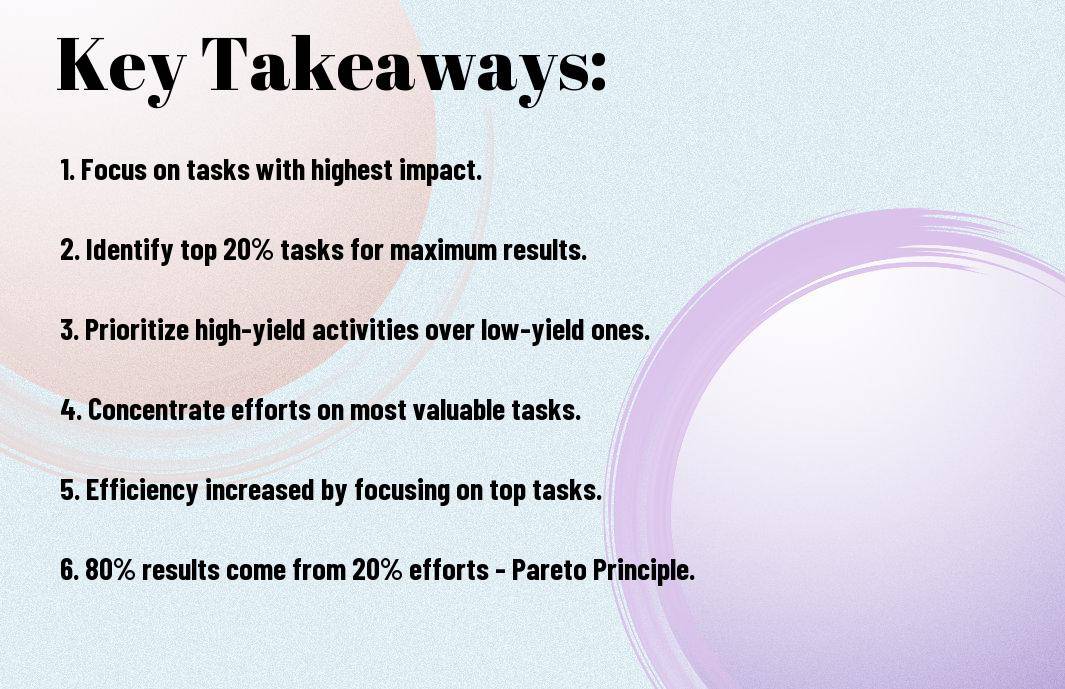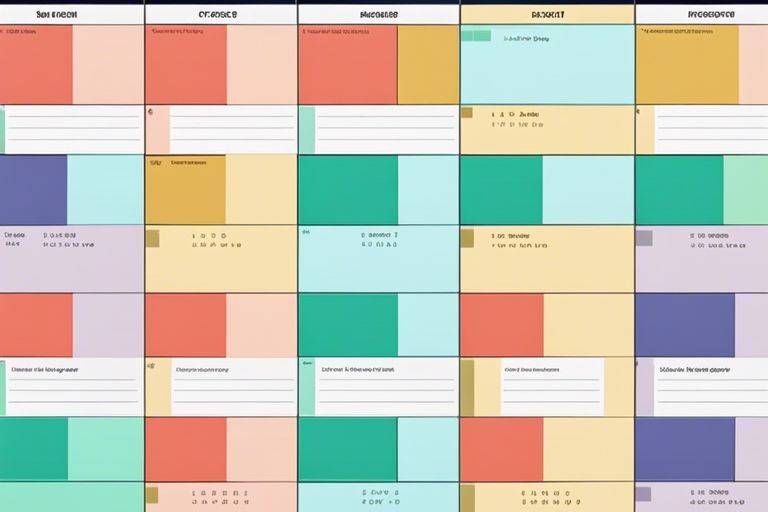The Pareto Principle, also known as the 80/20 rule, is a concept developed by economist Vilfredo Pareto that states approximately 80% of results come from 20% of efforts. This principle can be applied to various aspects of life, including productivity and time management. By understanding and utilizing this principle effectively, individuals can focus on high-yield tasks that will lead to the most significant outcomes.
Learning how to identify the most important tasks that contribute to the majority of results can help individuals prioritize their time and energy efficiently. This technique not only improves productivity but also allows for a more strategic approach to goal attainment. By incorporating Vilfredo Pareto’s 80/20 rule into daily routines, individuals can experience a significant boost in efficiency and effectiveness.
Key Takeaways:
- 80/20 Rule: The Pareto Principle states that roughly 80% of the effects come from 20% of the causes. This concept can be applied in various aspects of life to improve productivity and efficiency.
- Focus on High-Yield Tasks: Identify the 20% of tasks that contribute to 80% of your desired outcomes and prioritize them. This helps you focus your time and energy on tasks that yield the greatest results.
- Avoid Time-Wasting Activities: By understanding the 80/20 rule, you can avoid spending excessive time on tasks that have minimal impact on your goals. This allows you to allocate your resources efficiently.
- Increased Productivity: By concentrating on high-yield tasks, you can significantly increase your productivity and accomplish more in less time. This leads to better results and overall success.
- Optimize Resources: Applying the 80/20 rule helps you optimize resources by focusing on activities that generate the most significant returns. This leads to better resource management and utilization.
- Strategic Planning: Utilize the Pareto Principle in your strategic planning to identify key areas that can have the most impact on your goals. This enables you to make informed decisions and prioritize effectively.
- Continuous Improvement: By regularly reviewing and adjusting your tasks based on the 80/20 rule, you can consistently improve your efficiency and effectiveness. This continuous improvement drives progress and success over time.

Fundamentals of the Pareto Principle
Definition and Key Concepts
Some of the most effective strategies in time management and productivity improvement stem from the 80/20 Rule, also known as the Pareto Principle. This principle suggests that roughly 80% of outcomes result from 20% of causes. In essence, it highlights the imbalance where a minority of inputs lead to a majority of results. Understanding this concept is crucial for individuals and businesses looking to maximize their efforts and resources.
The Mathematics of the 80/20 Rule
On the mathematical front, the 80/20 Rule can be applied to various scenarios beyond productivity. Pareto Principle can be represented in different ratios (90/10, 70/30) but the underlying premise remains the same – a small portion of efforts yield a disproportionately large output. By identifying and focusing on the vital 20% that contribute significantly to results, individuals can make significant strides in their goals and objectives.

Application of the 80/20 Rule in Productivity
Identifying High-Yield Tasks
For effective application of the 80/20 rule in productivity, it is crucial to first identify high-yield tasks. The rule suggests that approximately 80% of results come from 20% of efforts. Therefore, it is vital to pinpoint the tasks that belong to this vital 20%. Start by analyzing your tasks and outcomes to determine which ones consistently lead to the most significant impact or results.
Strategies to Prioritize Effectively
Any successful prioritization strategy based on the 80/20 rule involves identifying tasks that align with your goals and have the highest potential for impact. Once you have identified these tasks, allocate your time and resources accordingly. Utilize tools like to-do lists, time blocking, or prioritization frameworks to ensure you are focusing on what truly matters.
Avoid falling into the trap of busyness over productivity. Focus on completing high-yield tasks first before moving on to less critical activities. This approach ensures that you make the most of your time and energy, leading to greater efficiency and overall success in your endeavors.

The Role of the 80/20 Rule in Business and Management
Enhancing Business Efficiency
To achieve optimal efficiency in business operations, the 80/20 rule can play a crucial role. By focusing on the vital few tasks that yield the most significant results, organizations can streamline their processes and maximize productivity. This principle suggests that approximately 80% of outcomes result from 20% of efforts, indicating that by identifying and prioritizing high-yield activities, businesses can achieve substantial improvements in efficiency.
By concentrating on the most impactful tasks, companies can make better use of their resources and time, ultimately leading to improved performance and profitability. This approach allows businesses to channel their efforts towards the areas that truly drive success while minimizing wasted resources on less critical tasks.
Resource Allocation and Investment Decisions
Management plays a central role in applying the 80/20 rule to make informed resource allocation and investment decisions. By recognizing that a small percentage of investment decisions can significantly impact overall outcomes, managers can strategically allocate resources to projects or areas with the highest potential for returns. This targeted approach can help organizations avoid spreading their resources too thin and focus on maximizing the impact of their investments.
For instance, by identifying the key projects or initiatives that drive the majority of results, managers can align resources accordingly. This targeted allocation ensures that the most critical areas receive the necessary support and attention, ultimately leading to better performance and sustained growth.

Implementing the 80/20 Rule in Personal Time Management
Despite its simplicity, the 80/20 rule can be a powerful tool for personal time management. By focusing on the most impactful tasks that bring the greatest results, individuals can optimize their productivity and efficiency.
Tools and Techniques for Everyday Use
Management tools such as to-do lists, time tracking apps, and calendar scheduling can aid in applying the 80/20 rule to daily routines. By prioritizing tasks based on their level of importance and impact, individuals can ensure that they are spending their time on activities that yield the highest returns.
Balancing Work and Personal Life
One of the common challenges individuals face is finding a balance between work responsibilities and personal life. This is where the 80/20 rule can be particularly beneficial, helping individuals identify key tasks that drive results both professionally and personally. By focusing on the activities that matter most, individuals can allocate their time and energy effectively, leading to a more harmonious balance between work and personal life.
The Impact of the 80/20 Rule on Decision Making
Analyzing Risk and Opportunity
Opportunity: Understanding the 80/20 rule can significantly impact decision-making when it comes to analyzing risk and opportunity. This principle suggests that roughly 80% of results come from 20% of actions. When applied to decision-making, it highlights the importance of identifying the critical 20% that leads to 80% of the desired outcomes. By focusing on high-yield tasks, individuals can prioritize their efforts on areas that will have the most significant impact.
Overcoming Analysis Paralysis
Impact: Overthinking and indecisiveness can hinder effective decision-making. The 80/20 rule can help individuals overcome analysis paralysis by emphasizing the importance of focusing on the most impactful tasks. By recognizing that not all decisions hold equal weight, individuals can streamline their thought process and allocate their time and resources more efficiently. This approach can lead to quicker and more effective decision-making, ultimately driving better outcomes.
Making: When faced with complex decisions, it’s crucial to remember the 80/20 rule and prioritize tasks based on their impact. By honing in on the vital few tasks that yield significant results, individuals can make more informed decisions that maximize their efficiency and productivity. By applying the 80/20 rule to decision-making, individuals can navigate through choices with a clear focus on high-yield tasks.
Limitations and Common Misconceptions
Recognizing When the 80/20 Rule Does Not Apply
To fully leverage the benefits of the 80/20 Rule, it is vital to recognize situations where this principle may not be applicable. Unlike other universal laws, the 80/20 Rule is not a one-size-fits-all solution and may not hold true in every scenario. One common misconception is assuming that the distribution of inputs and outputs will always follow an 80/20 ratio. However, this ratio is a general guideline rather than a strict rule.
To avoid misapplication, it is crucial to assess each situation individually and determine whether the 80/20 Rule is relevant. In some cases, the distribution may be closer to 70/30 or even 90/10. Understanding the nuances of each specific context is key to effectively applying this principle.
Avoiding Over-Simplification and Misinterpretation
The 80/20 Rule can be a powerful tool when used correctly, but it is important to guard against over-simplification and misinterpretation. For instance, some may mistakenly assume that focusing solely on the top 20% of tasks will lead to optimal results. While prioritizing high-yield activities is vital, it is also crucial to consider the interplay between different tasks and how they contribute to overall efficiency.
Conclusion
Considering all points, it is clear that the 80/20 Rule, based on Vilfredo Pareto’s observation, can be an invaluable technique for agencies looking to maximize productivity and efficiency. By focusing on the high-yield tasks that generate the most results, agencies can prioritize their efforts and resources effectively. This principle can be applied to various aspects of agency operations, helping teams streamline workflows and achieve better outcomes. For more insights on utilizing the 80/20 Rule in your agency, check out Applying the 80/20 Rule (Pareto Principle) to Your Agency.
FAQ
Q: What is the 80/20 Rule (Pareto Principle)?
A: The 80/20 Rule, also known as the Pareto Principle, states that roughly 80% of the effects come from 20% of the causes. This principle suggests that a small portion of input leads to the majority of results.
Q: Who developed the 80/20 Rule?
A: The 80/20 Rule is named after Vilfredo Pareto, an Italian economist and sociologist who first observed this phenomenon in 1896 while studying the distribution of wealth in Italy.
Q: How can the 80/20 Rule be applied in daily life?
A: You can apply the 80/20 Rule by focusing on the most important tasks that contribute to the majority of your desired outcomes. Identify the vital few tasks that yield the most significant results and prioritize them over less impactful activities.
Q: What are the benefits of applying the 80/20 Rule?
A: By following the 80/20 Rule, you can increase your productivity, efficiency, and effectiveness. It helps you concentrate on tasks that produce the highest returns and avoid wasting time and energy on less important activities.
Q: How can businesses benefit from the 80/20 Rule?
A: Businesses can benefit from the 80/20 Rule by focusing on their most profitable products, customers, and efforts. By identifying and prioritizing the key factors that drive success, organizations can optimize resources and improve overall performance.
Q: Is the 80/20 Rule applicable to time management?
A: Yes, the 80/20 Rule can be applied to time management by identifying the most critical tasks that contribute significantly to your goals. By concentrating on high-yield activities, you can make better use of your time and accomplish more in less time.
Q: How can individuals implement the 80/20 Rule effectively?
A: To implement the 80/20 Rule effectively, individuals should evaluate their tasks and responsibilities, identify the most impactful ones, and allocate more time and effort to them. Regularly review and adjust your priorities based on the outcomes to stay focused on high-yield tasks.
Expand Your Knowledge
Eisenhower Matrix – Dwight D. Eisenhower’s Strategy to Prioritize Tasks by Urgency and Importance
The 50/10 Rule – Managing Work and Break Times for Enhanced Productivity
Unmatched Productivity – Ultimate Guide to Harnessing Your Second Brain
Eat That Frog – Brian Tracy’s Approach to Tackling the Most Challenging Task First
Pomodoro Technique – Francesco Cirillo’s Method to Improve Focus and Manage Time



